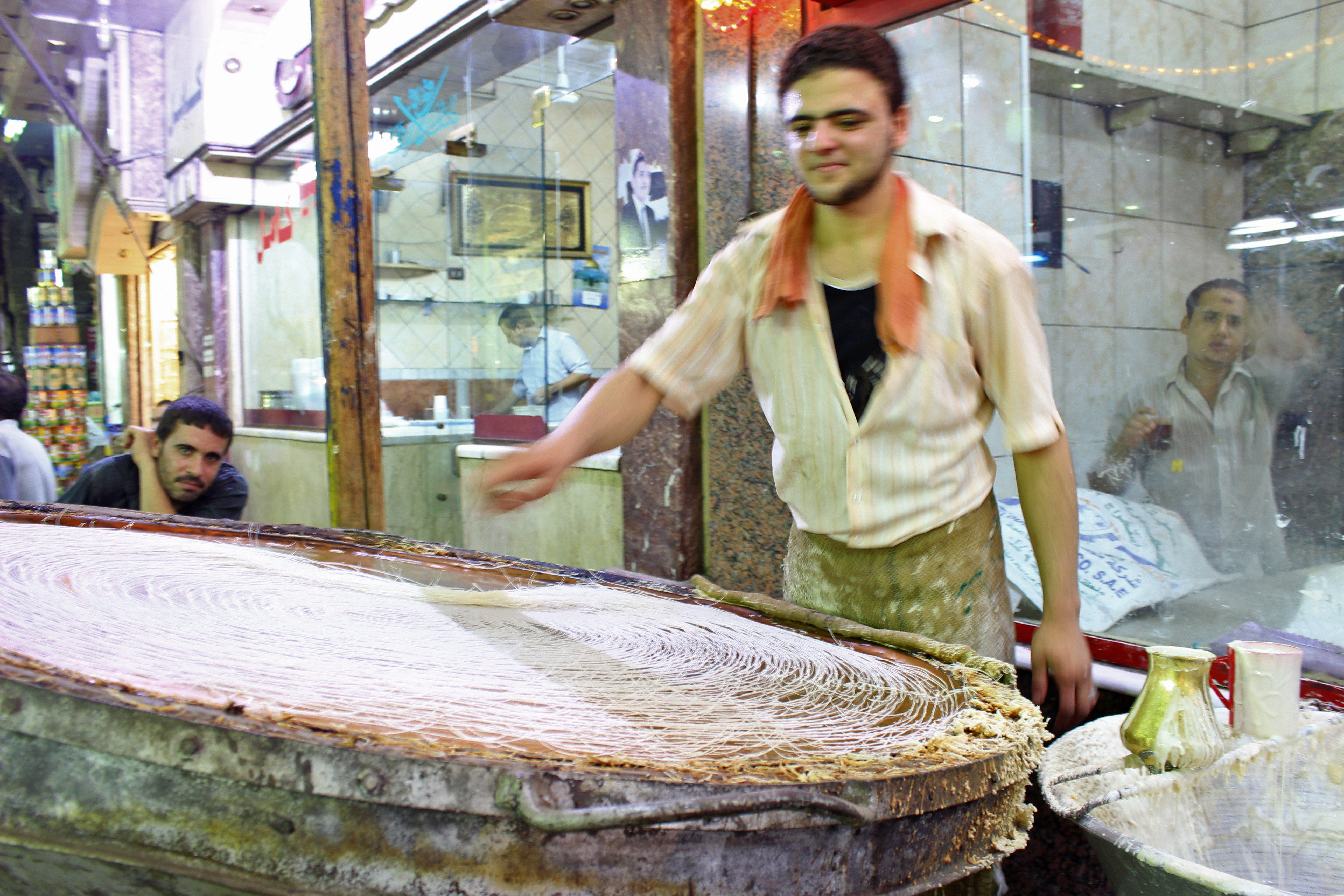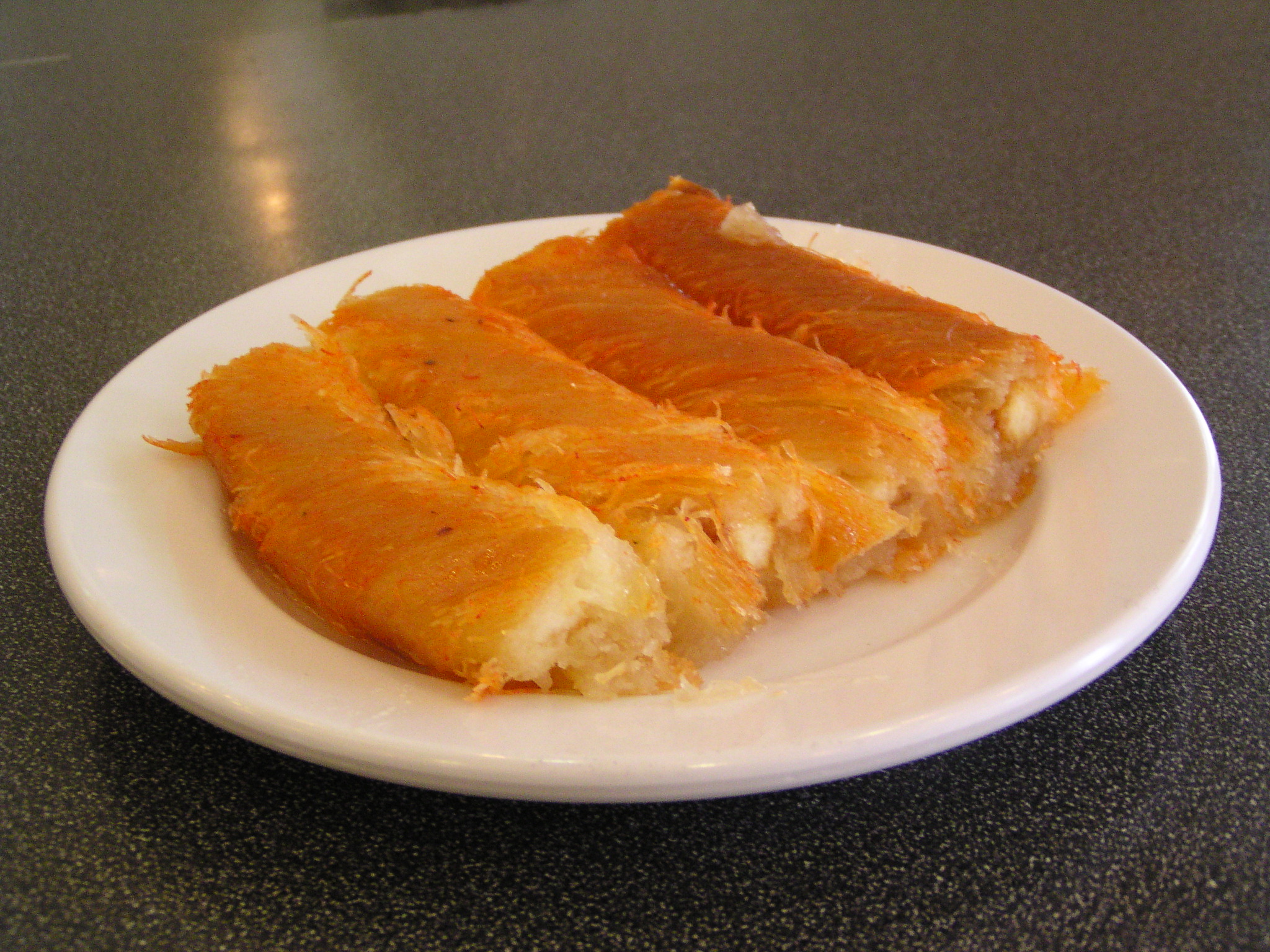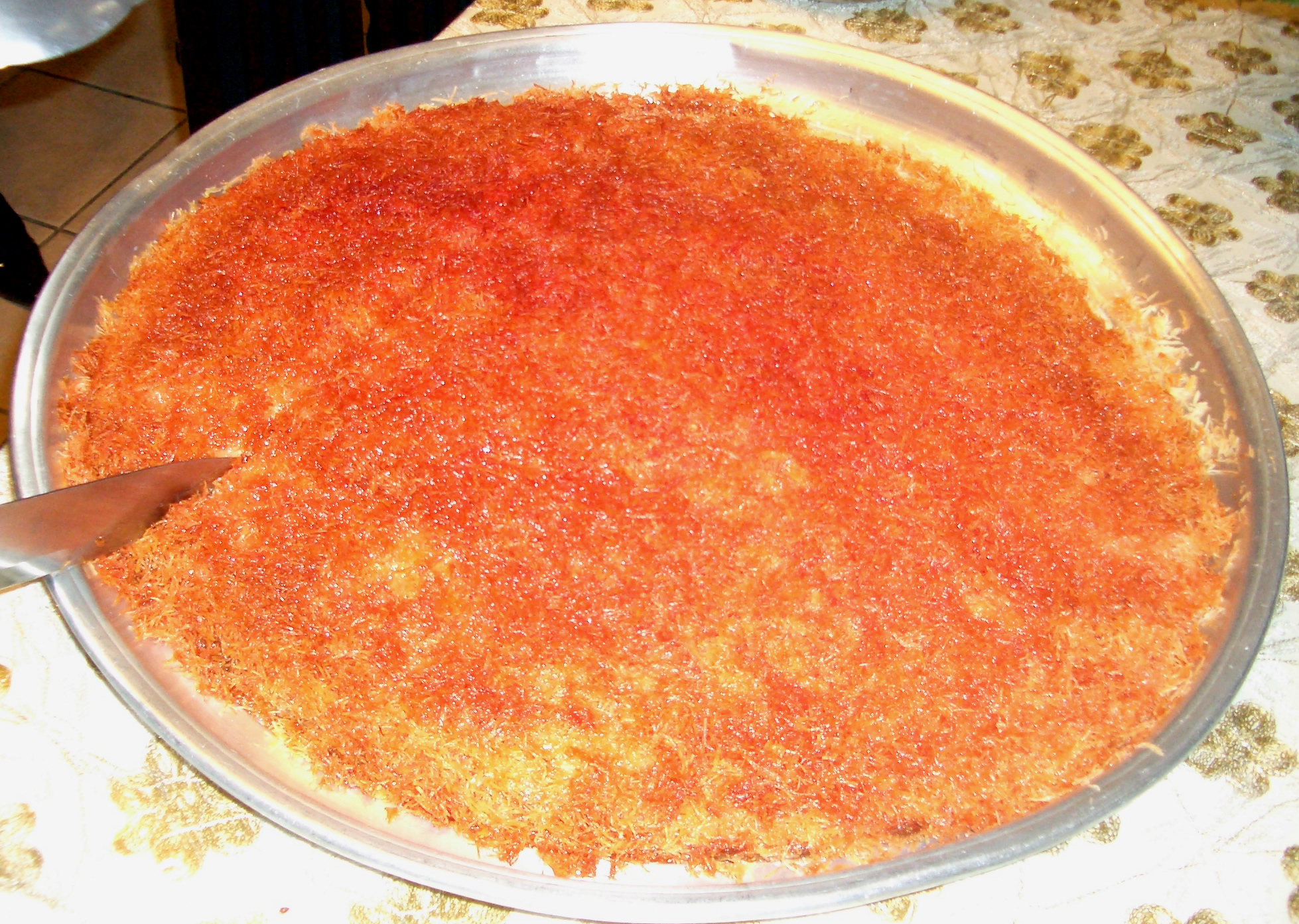Kanafeh Nabulsieh.jpg on:
[Wikipedia]
[Google]
[Amazon]
Knafeh ( ar, كنافة) is a traditional Middle Eastern dessert made with spun pastry called ''kataifi'', soaked in a sweet, sugar-based syrup called Attar (syrup), attar, and typically layered with cheese, or with other ingredients such as clotted cream, pistachio or nuts, depending on the region. It is popular in the Middle East. Variants are also found in Turkey, Greece, and the Balkans.
In Arabic, the name may refer to the string pastry itself, or to the entire dessert dish. In Turkish, the string pastry is known as , and the cheese-based dessert that uses it as . In the Balkans, the shredded dough is similarly known as , and in Greece as , and is the basis of various dishes rolled or layered with it, including dessert pastries with nuts and sweet syrups.
One of the most well-known preparations of the dessert is ''knafeh Nabulsiyeh'', which originated in the city of Nablus, and is the most representative Palestinian cuisine#Sweets, Palestinian dessert. uses a white-Brined cheese, brine cheese called Nabulsi cheese, Nabulsi. It is prepared in a large round shallow dish, the pastry is colored with orange or red food coloring, and sometimes topped with crushed pistachio nuts.
 The 13th century anonymous (''Book of Dishes from Maghreb and Al-Andalus'') uses the word to describe a crêpe made with thin batter on an Indian pan or "mirror" (the ), and says it is equivalent to . It also gives a recipe for (the crêpes being called in Al-Andalus), which uses the same batter, but the is made thinner, "like a fine tissue". It gives a number of dessert recipes for , where the crêpes are served layered with fresh cheese, baked, and topped with honey and rose syrup; or cut up into shreds like rose leaves and cooked with honey, nuts, sugar, and Rose water, rosewater. See als
The 13th century anonymous (''Book of Dishes from Maghreb and Al-Andalus'') uses the word to describe a crêpe made with thin batter on an Indian pan or "mirror" (the ), and says it is equivalent to . It also gives a recipe for (the crêpes being called in Al-Andalus), which uses the same batter, but the is made thinner, "like a fine tissue". It gives a number of dessert recipes for , where the crêpes are served layered with fresh cheese, baked, and topped with honey and rose syrup; or cut up into shreds like rose leaves and cooked with honey, nuts, sugar, and Rose water, rosewater. See als
contents
an
/ref> Ibn al-Jazari gives an account of a 13th-century market inspector who rode through Damascus at night, ensuring the quality of , and other foods associated with Ramadan, during the Mamluk Sultanate (Cairo), Mamluk period. In the later Middle Ages, a new technique was created, with thin batter being dripped onto the metal sheet from a perforated container, creating hair-like strings. A mid-15th century Ottoman Turkish translation of Muhammad bin Hasan al-Baghdadi's added several new contemporary recipes, including one for this , though it does not specify where it originated. This became the basis for the modern . It is fried together with butter and fillings or toppings such as nuts, sweetened cheese, or clotted cream, and mixed with rosewater and sugar. The pastry spread from the Arab lands to neighboring countries including Iran and Greece, and to Turkey where the string pastry itself is known as ("string crêpes"), also used in related pastries such as .
 There are many types of kanafeh pastry:
* ''khishnah'' ( ar, خشنة, rough): crust made from long thin noodle threads.
* ''nāʿimah'' ( ar, ناعمة, fine): semolina dough.
* ''muhayara'' ( ar, محيرة, mixed): a mixture of ''khishnah'' and ''na'ama''.
* ''mabruma'' ( ar, مبرومة, twined): It is prepared with noodle.
The pastry is heated in butter, margarine, palm oil, or traditionally semneh and then spread with soft white cheese, such as Nabulsi cheese, and topped with more pastry. In ''khishnah kanafeh'' the cheese is rolled in the pastry. A thick syrup of sugar, water, and a few drops of rose water or orange blossom water is poured on the pastry during the final minutes of cooking. Often the top layer of pastry is tinted with red food coloring (a modern shortcut, instead of baking it for long periods of time). Crushed pistachios are sprinkled on top as a garnish.
There are many types of kanafeh pastry:
* ''khishnah'' ( ar, خشنة, rough): crust made from long thin noodle threads.
* ''nāʿimah'' ( ar, ناعمة, fine): semolina dough.
* ''muhayara'' ( ar, محيرة, mixed): a mixture of ''khishnah'' and ''na'ama''.
* ''mabruma'' ( ar, مبرومة, twined): It is prepared with noodle.
The pastry is heated in butter, margarine, palm oil, or traditionally semneh and then spread with soft white cheese, such as Nabulsi cheese, and topped with more pastry. In ''khishnah kanafeh'' the cheese is rolled in the pastry. A thick syrup of sugar, water, and a few drops of rose water or orange blossom water is poured on the pastry during the final minutes of cooking. Often the top layer of pastry is tinted with red food coloring (a modern shortcut, instead of baking it for long periods of time). Crushed pistachios are sprinkled on top as a garnish.
 ''Kanafeh Nabulsieh'' originated in the Palestinian people, Palestinian city of Nablus, hence the name ''Nabulsieh''. Nablus is still renowned for its kanafeh, which consists of mild white cheese and shredded wheat surface, which is covered by sugar syrup. In the Middle East, this variant of ''kanafeh'' is the most common.
''Kanafeh Nabulsieh'' originated in the Palestinian people, Palestinian city of Nablus, hence the name ''Nabulsieh''. Nablus is still renowned for its kanafeh, which consists of mild white cheese and shredded wheat surface, which is covered by sugar syrup. In the Middle East, this variant of ''kanafeh'' is the most common.
 In this variant, called also () or () in Greek, the threads are used to make various forms of pastries, such as tubes or birds' nests, often with a filling of chopped nuts as in baklava.
These very thin threads are also known as "kadaif noodles" and are used to make the outer shell of the Greek dessert kataifi. These vermicelli-like threads become very crispy when fried or baked, which is why the kataifi provides a nice crunch when you bite into it. For this particular Greek dessert, the filling is usually a blend of coarsely chopped nuts, such as walnuts and pistachios, mixed with honey and a light cream.
In this variant, called also () or () in Greek, the threads are used to make various forms of pastries, such as tubes or birds' nests, often with a filling of chopped nuts as in baklava.
These very thin threads are also known as "kadaif noodles" and are used to make the outer shell of the Greek dessert kataifi. These vermicelli-like threads become very crispy when fried or baked, which is why the kataifi provides a nice crunch when you bite into it. For this particular Greek dessert, the filling is usually a blend of coarsely chopped nuts, such as walnuts and pistachios, mixed with honey and a light cream.
File:Jerusalem Kanafeh (3783936961).jpg, Knafeh in Jerusalem
File:Kunafeh.jpg, Kanafeh (na'ama) fine
File:كنافة نابلسية.jpg, Knafeh Nablus, Nabulsieh
File:Kanafeh.jpg, Knafeh shop, old city of Jerusalem
File:Pistachio Kadayif (Unsplash).jpg, Knafeh with pistachio
Etymology
The English language borrows the word from Levantine Arabic, Levantine and Egyptian Arabic, and widely transliterates it as , and similar variations. Its form in Arabic, , renders as when transliterated. The ultimate origin of is debated. Some sources state that it comes from the Coptic language, Coptic Egyptian word , meaning a bread or cake. Early attestations are found in Egyptian stories in the ''One Thousand and One Nights''. Another view is that it comes from a Semitic root with a meaning of "side" or "wing", from the Arabic , "to flank or enclose". According to etymologist Sevan Nişanyan, the Turkish term ("string-pancake" or "string-crêpe"), referring to the vermicelli-like pastry often used in kanafeh and other dishes, is based on the Arabic word (a pancake or crêpe). It appears in 1501 in a Turkish-Persian dictionary.History
A common story is that the dish was created, and prescribed by doctors, to satisfy the hunger of caliphs during Ramadan. The story is variously said to have happened in Fatimid Caliphate, Fatimid Egypt, or in the Umayyad Caliphate in Syria. It is also reported to have been mentioned in writing as early as the tenth century, and to be of Fatimid origin. However, dishes mentioned in historical texts are not necessarily the same as the modern versions of . Ibn Sayyar al-Warraq's tenth century (''Book of Dishes''), a collection of Arabic and Persian recipes and food advice of the Abbasid caliphs, mentions neither the word , nor a description of the dish as it is known today. However, it does feature a chapter on desserts made with the related , meaning crêpes, from which the Turkish word and Greek word derive. In one recipe, are stuffed with nuts, deep-fried, and topped with honey-sugar syrup, which is essentially unchanged in today's version. Also described are large thin crêpes resembling fabric, called , cooked on a round sheet of metal called a , layered with fruit, and drenched with sugar. The 13th century anonymous (''Book of Dishes from Maghreb and Al-Andalus'') uses the word to describe a crêpe made with thin batter on an Indian pan or "mirror" (the ), and says it is equivalent to . It also gives a recipe for (the crêpes being called in Al-Andalus), which uses the same batter, but the is made thinner, "like a fine tissue". It gives a number of dessert recipes for , where the crêpes are served layered with fresh cheese, baked, and topped with honey and rose syrup; or cut up into shreds like rose leaves and cooked with honey, nuts, sugar, and Rose water, rosewater. See als
The 13th century anonymous (''Book of Dishes from Maghreb and Al-Andalus'') uses the word to describe a crêpe made with thin batter on an Indian pan or "mirror" (the ), and says it is equivalent to . It also gives a recipe for (the crêpes being called in Al-Andalus), which uses the same batter, but the is made thinner, "like a fine tissue". It gives a number of dessert recipes for , where the crêpes are served layered with fresh cheese, baked, and topped with honey and rose syrup; or cut up into shreds like rose leaves and cooked with honey, nuts, sugar, and Rose water, rosewater. See alscontents
an
/ref> Ibn al-Jazari gives an account of a 13th-century market inspector who rode through Damascus at night, ensuring the quality of , and other foods associated with Ramadan, during the Mamluk Sultanate (Cairo), Mamluk period. In the later Middle Ages, a new technique was created, with thin batter being dripped onto the metal sheet from a perforated container, creating hair-like strings. A mid-15th century Ottoman Turkish translation of Muhammad bin Hasan al-Baghdadi's added several new contemporary recipes, including one for this , though it does not specify where it originated. This became the basis for the modern . It is fried together with butter and fillings or toppings such as nuts, sweetened cheese, or clotted cream, and mixed with rosewater and sugar. The pastry spread from the Arab lands to neighboring countries including Iran and Greece, and to Turkey where the string pastry itself is known as ("string crêpes"), also used in related pastries such as .
Preparation
 There are many types of kanafeh pastry:
* ''khishnah'' ( ar, خشنة, rough): crust made from long thin noodle threads.
* ''nāʿimah'' ( ar, ناعمة, fine): semolina dough.
* ''muhayara'' ( ar, محيرة, mixed): a mixture of ''khishnah'' and ''na'ama''.
* ''mabruma'' ( ar, مبرومة, twined): It is prepared with noodle.
The pastry is heated in butter, margarine, palm oil, or traditionally semneh and then spread with soft white cheese, such as Nabulsi cheese, and topped with more pastry. In ''khishnah kanafeh'' the cheese is rolled in the pastry. A thick syrup of sugar, water, and a few drops of rose water or orange blossom water is poured on the pastry during the final minutes of cooking. Often the top layer of pastry is tinted with red food coloring (a modern shortcut, instead of baking it for long periods of time). Crushed pistachios are sprinkled on top as a garnish.
There are many types of kanafeh pastry:
* ''khishnah'' ( ar, خشنة, rough): crust made from long thin noodle threads.
* ''nāʿimah'' ( ar, ناعمة, fine): semolina dough.
* ''muhayara'' ( ar, محيرة, mixed): a mixture of ''khishnah'' and ''na'ama''.
* ''mabruma'' ( ar, مبرومة, twined): It is prepared with noodle.
The pastry is heated in butter, margarine, palm oil, or traditionally semneh and then spread with soft white cheese, such as Nabulsi cheese, and topped with more pastry. In ''khishnah kanafeh'' the cheese is rolled in the pastry. A thick syrup of sugar, water, and a few drops of rose water or orange blossom water is poured on the pastry during the final minutes of cooking. Often the top layer of pastry is tinted with red food coloring (a modern shortcut, instead of baking it for long periods of time). Crushed pistachios are sprinkled on top as a garnish.
Variants
Kanafeh Nabulsieh
 ''Kanafeh Nabulsieh'' originated in the Palestinian people, Palestinian city of Nablus, hence the name ''Nabulsieh''. Nablus is still renowned for its kanafeh, which consists of mild white cheese and shredded wheat surface, which is covered by sugar syrup. In the Middle East, this variant of ''kanafeh'' is the most common.
''Kanafeh Nabulsieh'' originated in the Palestinian people, Palestinian city of Nablus, hence the name ''Nabulsieh''. Nablus is still renowned for its kanafeh, which consists of mild white cheese and shredded wheat surface, which is covered by sugar syrup. In the Middle East, this variant of ''kanafeh'' is the most common.
Kadayıf and künefe
In the Hatay Province, Hatay region of Turkey, which was formerly part of Syria and has a large Arab population, the pastry is called ''künefe'' and the wiry shreds are called ''tel kadayıf''. A semi-soft cheese such as ''Urfa peyniri'' (cheese of Şanlıurfa Province, Urfa) or ''Hatay peyniri'' (cheese of Hatay Province, Hatay), made of raw milk, is used in the filling. In making the ''künefe'', the ''kadayıf'' is not rolled around the cheese; instead, cheese is put in between two layers of wiry ''kadayıf''. It is cooked in small copper plates, and then served very hot in syrup with clotted cream (''kaymak'') and topped with pistachios or walnuts. In the Turkish cuisine, there is also yassı kadayıf and ekmek kadayıfı, none of which is made of wiry shreds.Riştə xətayi
This Iranian Azerbaijanis, South Azerbaijani variant is prepared in Tabriz, Iran. ''Riştə xətayi'' is typically cooked in Ramadan in the world's biggest covered Bazaar of Tabriz. It is made with chopped walnuts, cinnamon, ginger, Rosa × damascena#Culinary uses, powder of rose, sugar, rose water and olive oil.Kadaif
 In this variant, called also () or () in Greek, the threads are used to make various forms of pastries, such as tubes or birds' nests, often with a filling of chopped nuts as in baklava.
These very thin threads are also known as "kadaif noodles" and are used to make the outer shell of the Greek dessert kataifi. These vermicelli-like threads become very crispy when fried or baked, which is why the kataifi provides a nice crunch when you bite into it. For this particular Greek dessert, the filling is usually a blend of coarsely chopped nuts, such as walnuts and pistachios, mixed with honey and a light cream.
In this variant, called also () or () in Greek, the threads are used to make various forms of pastries, such as tubes or birds' nests, often with a filling of chopped nuts as in baklava.
These very thin threads are also known as "kadaif noodles" and are used to make the outer shell of the Greek dessert kataifi. These vermicelli-like threads become very crispy when fried or baked, which is why the kataifi provides a nice crunch when you bite into it. For this particular Greek dessert, the filling is usually a blend of coarsely chopped nuts, such as walnuts and pistachios, mixed with honey and a light cream.
Gaza knafeh
It originated in Gaza Strip, Palestine, and is made of soft bulgur, cinnamon, pecan nuts, and dairy fats.World records
The world's largest plate of the dessert was made in Antakya, Turkey, in 2017. The tray of ''künefe'' measured 78 meters long, and weighed 1550 kilograms. A previous record attempt was made by rival Nablus in 2009, with a 75-meter tray, weighing 1,350 kilograms. Neither attempt was officially listed as breaking the record; according to the website of the Guinness World Records, there is no current record holder for the title.See also
* Ekmek kadayıfı, Turkish bread custard * List of pastries * Palestinian cuisine * Phyllo * Qatayef, a dumpling-like confection involving some of the same ingredientsGallery
References
External links
* {{pastries Arab desserts Arab pastries Ottoman cuisine Egyptian cuisine Jordanian cuisine Lebanese cuisine Levantine cuisine Palestinian cuisine Syrian cuisine Turkish desserts Stuffed desserts Cheese desserts Albanian cuisine